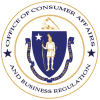- Office of Consumer Affairs and Business Regulation
Consumers deserve to feel confident that the price they see advertised in stores is the price they’re going to pay. That’s why the state’s Division of Standards (DOS) annually inspects retail stores to make sure their pricing is accurate. While overall inspectors find accurate pricing, it is still important to be vigilant when shopping.
In order to protect yourself from being overcharged for items, make sure to double check prices at checkout or on your receipt before you leave because there are rules stores must follow if an item rings up at a higher than advertised price.
If your item is food (purchased at a grocery store or other similar store):
Under 202 CMR 7.00, food stores or food departments are broken down into two distinct categories.
- The first type is known as individual item pricing stores. This means that most every item for sale in this store is individually labeled with a price sticker. Some items, such as milk or candy, can be exempt because of how quickly they sell.
- In this type of store, if an item rings up at a higher price than was indicated the store shall charge the consumer the lowest advertised price.
- The second type is a known as a waiver store. This means the store applied for and received a waiver from the Division that allows them to remove the pricing stickers from each individual item. This kind of store uses shelf signs to indicate prices and must have obvious signage directing consumers to the nearest in-aisle scanner so that prices can be double checked. If a grocer offers a rewards or discount card, the regular price must also be displayed alongside the discounted price.
- In this type of store, there must be a visible sign posted at each checkout register stating that in the event of an overcharge, the incorrectly scanned item (if priced under ten dollars) must be given to a consumer for free; Any item priced over ten dollars that rings up incorrectly must be given for the price after subtracting ten dollars off the overcharged total.
Keep in mind that there is also an exception to these procedures that protects the stores from careless errors of price marking that are over 50% of what the item was intended to be sold for. That is called a gross error and in that instance, the item would be given at the original intended price.
If your purchase isn’t food (or its food purchased at a restaurant, drive-thru, movie theater, etc):
- The Massachusetts Consumer Protection Act requires truth in advertising. Unless the item is marked incorrectly in gross error, the product should be rung up at the advertised price. The seller must then correct the incorrectly advertised price using the same medium that is was displayed (via sign, online ad, newspaper ad).
Price Matching:
While a store cannot charge you more than the lowest advertised, marked or shelf tag price, sometimes a change in the price is in your favor! Keep an eye out for stores that offer a “price match guarantee”. These stores may match their competitors’ prices (sometimes including competing stores that are online-only, such as Amazon).
If you notice that a store’s online price is lower than the on-shelf price, speak up. You can often compare the prices by searching the QR code on the store’s website and show the different price to your cashier!
For more information on price accuracy, visit the Division’s website.

